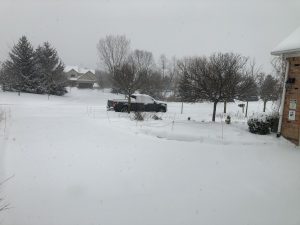I am sitting in my office on this snowy February day, provisions on board, seeing no need to slide around the roads. The snow is clean and quiet and I think about what a day like this 250 years ago was like before the time we made drastic modifications to our landscapes. I think a snowy day best approximates a time from the past because of its seeming purity and stillness.
As I look out the window, I can still see last year’s vegetation standing in my rain gardens and perennial beds providing shelter to insects and small creatures. I know the Cardinal Flower, Blue Lobelia, Columbine, and Nodding Onion are green underneath the snow and, as we enter late winter and increasing daylight, other plants are starting to stir as well. Of course, there are those plants that are still in their deep winter slumber. I’m thinking White Wild Indigo, Baptisis alba, which doesn’t emerge from the ground in my rain garden until late May.
I think forward to the time later this year when my landscape will be abuzz with pollinators, full of birds hunting insects, and speckled with roving hawks looking for lunch. The cycles are continuous. The cycles are being disturbed. I’m both hopeful and worried about the future of our landscapes.
If you’re here, I think we share a longing for the natural world and work to approximate this around us to the extent possible. Some of us create in our front and backyards and others at schools and places of work and worship. We are land owners, volunteers, students, teachers, professionals, and observers.
I think a lot about about bringing wildness and ecological value back into our landscapes while still meeting aesthetic goals. Through Facebook posts https://www.facebook.com/CreatingSustainableLandscapes/ and hopefully a new dedication to my blog, I hope you leave with some solutions to issues you have struggled with, more questions than you came with, and a couple new friends. Let me know what you’re thinking.



